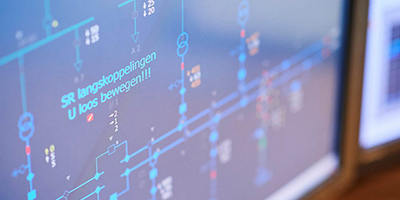08 January 2023
Forecasting deterministic frequency deviations using artificial intelligence
European electricity production and shifts in demand undergo periodic schedule changes according to market clearance on an hourly basis.
Why this project
The changes in the ramp-up or ramp-down flows can occur faster (HVDC, hydro, gas), or slower (nuclear, coal, load), either in upward or downward shifts that could occur in the morning or evening. The imbalances resulting from this mismatch affect the frequency, specially, around the seasonal hour change. Forecasting their occurrence would give an early warning that could be a trigger for a preventive mitigation measure.
Approach
The forecast module is based on an artificial neural network (ANN). The input data are defined based on statistical analysis and expert cognitive view in order In order to determine as many factors as possible to a deterministic frequency deviation occurrence.
The forecasting module is integrated within the main tool to allow the decision maker to take possible mitigation measures taking into account the risks with regard to the cost-efficiency factor.
For the training and testing of the machine learning performance, an exhaustive set of operational scenarios is used to cover as many as possible occurrences and to allow the model to emulate the complex system behavior.
-
Cost-efficient mitigation measuresThe pilot project aimed to utilize cost-efficient mitigation measures, thanks to binary classification. The tool allows the user to fine-tune the forecasting accuracy by choosing the acceptable threshold between False Negative (FN) & False Positive (FP) forecasting. Specifically, this comes down to the level of exposure that is acceptable (FN occurrence means that an event did occur but was not forecasted) against the resulting costs of higher mitigation activation (FP occurrence means the ML predicts an event while in reality this would not occur).
-
Using TensorFlowThe pilot case has been developed using open library (TensorFlow) and publicly available data from a transparency platform in order to investigate the feasibility of such a concept.
-
Adjustment of the performanceThe tool allows users to adjust their perfomances by directly by adapting hyper parameters of the ANN (strictly ML’s forecasting performance), or by adjusting the design parameters to optimize the trade-off between risk exposure and the underlying costs (overall process performance), such optimization can be interesting to adjust throughout different time frames as priorities can vary.
Results
The results have already been presented within ENTSO-E System Frequency Sub Group, the approach and the obtained positive results have triggered the interest for possible follow-ups for the application at regional level and for the exchange of experience among other TSOs.
The obtained results using 2019/2020 data for training and validation were very satisfactory considering the 20 % recall factor which resulted in a reduction of costs of possible mitigation actions around 60 % while maintaining the same level of risk exposure. Although such mitigation measures are not required at the Belgian level, this approach can be implemented at synchronous area level if it is technically required in a cost-efficient approach. Future improvement could involve a joint forecasting of DFD occurrence that should be combined with large imbalances at control block level, which coordinate both behaviors of the system at a regional and local level.



